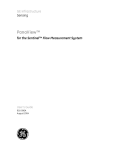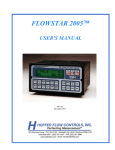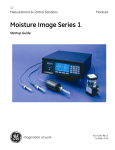Download M-Band J Series Compact Medium Power Amplifier VZM
Transcript
811 Hansen Way Palo Alto, CA 94303 Phone: (650) 846-3700 Fax: (650) 424-1744 Technical Description M-Band J Series Compact Medium Power Amplifier VZM-6993J4 INTRODUCTION This document provides a detailed technical description of the Communications & Power Industries, Inc. (CPI), VZM-6993J4 Series M-band Compact Medium Power Amplifier (CMPA), a 250 Watt medium power traveling wave tube amplifier designed specifically for broadband microwave applications such as EMC and general purpose testing. The J Series CMPA is compact and lightweight and employs a state-of-the-art wideband Traveling Wave Tube (TWT). The TWT permits continuous, efficient instantaneous operation across the entire 8.0 to 18.0 GHz frequency. The J Series CMPA also incorporates the use of a microprocessor control system, thereby simplifying interfacing with remote control and monitor facilities. Both RS 422/485 and IEEE-488 interface ports are included as standard features. Microwave features include a Solid State Intermediate Power Amplifier (SSIPA), microprocessor controlled RF gain control and soft-fail VSWR protection. The J Series CMPA also features active power factor correction (0.95 min.) which allows the unit to meet the total harmonic distortion requirement of EN60555-2. It is also designed to meet EN61010 safety and 89/336/EEC electromagnetic compatibility requirements. The VZM-6993J4 Series CMPA along with the VZS/C-6963J2 (2.0 – 8.0 GHz) and the VZL-6943J2 (1.0 – 2.5 GHz), cover the full 1.0 – 18.0 GHz in three units. The J Series CMPA family is a member of a comprehensive line of communication amplifiers including TWT Low Power Amplifiers (LPAs), Medium Power Amplifiers (MPAs), High Power TWT Amplifiers (HPAs) and High Power Klystron Amplifiers (KPAs) designed specifically for service in commercial satellite earth stations operating in standard SATCOM frequency bands. CPI (formerly Varian Electron Device Group) has been active in the design and manufacture of microwave power amplifiers and related products for more than 30 years. CPI Satcom Division (formerly Varian MEP), was organized in the mid-1970s to bring together under a single business center the strengths of existing groups involved with commercial Satcom and Industrial power amplifiers. Today, CPI Satcom Division has provided thousands of fully integrated satellite uplink power amplifiers in the S, C, Ku, X, M, DBS and Ka- band frequency ranges to worldwide users and has become the leading supplier of this class of products. M-Band J Series CMPA M-Band J Series CMPA (VZM-6993J4) 04/00 TD-82 1 EQUIPMENT DESCRIPTION General The VZM-6993J4 CMPA (Figure 1) is packaged in a 5.25 inch tall slide-mounted drawer suitable for standard 19-inch rack mounting. This enclosed assembly houses both the RF and power supply sections of the amplifier. The RF section includes the TWT, solid state intermediate power amplifier (IPA), optional Input Isolator, input RF Gain control, RF detectors and output directional couplers for monitoring and protection. The power supply section includes the power factor correction, power processor, and high voltage regulation circuitry. It also contains all monitor, control and protection circuits necessary to permit safe, efficient and reliable operation of the J Series CMPA . The VZM-6993J4 CMPA is protected from operational damage caused by abnormal AC, DC, RF faults or insufficient cooling. The amplifier will automatically recycle itself after a prime power interruption or transient fault condition. Personnel safety is of utmost importance and is safeguarded by proper grounding and by access interlocks and shields, which prevent physical entry into the high voltage sections. ME TER S ELE The front panel of the unit serves as the primary user interface housing all monitor and control functions including a type N RF connector to sample and measure output RF power. Opening the small access door on the front panel allows easy access to configuration DIP switches that can be set during installation, up/down buttons that permit setting high and low alarm trip points (such as Low RF), and a set of detail fault LEDs to help troubleshoot during operation. Principal functions are also brought to the four user interface connectors located on the rear panel for remote monitor and control. Control, fault and monitoring functions are available via: the IEEE-488 interface designed to interface directly with a computer, an RS422/485 port to be used when the optional CPI remote control panel is purchased, a separate switching port for use with switching/power combining subsystems, and a user interlock port for use when interfacing other equipment or controls with the J Series CMPA. Digital attenuation allows for RF drive attenuation adjustment via the remote interface ports thereby enhancing remote monitor and control capabilities. CT LOCAL RF REM OU TPUT (dB OU m) TPUT ATTE (W) NUA TOR REFL SETT ECTE ING DR (V) F(W) X CUR RENT HELI X VO (mA) LTAG E(kV) OTE RF CIF HELI HTD TX T RA N S MI T STA NDB Y RE S SELE CT STAN D BY ET TRAN SM IT REC LO C AL RE M OT E CI F YCLE FAUL D T FAUL T RF RF SET TIN SAM P G 0 1 Figure 1. J Series CMPA M-Band J Series CMPA (VZM-6993J4) 04/00 TD-82 2 To expedite field maintenance procedures, the VZM6993J4 CMPA utilizes a modular design approach consisting of Line Replaceable Units (LRUs), which permit service personnel to maintain the J Series CMPA in the field without need of returning the entire unit to the depot or factory. Comprehensive built-intest (BIT) sequences and diagnostic procedures allow field personnel to localize the fault to the individual LRU, make the necessary replacement and return the amplifier to service with a minimum of operational downtime. input is then routed to the SSIPA which includes an internal variable RF attenuator. The attenuator, has a user control range of 20 dB plus an additional 15 dB of range for the soft-fail VSWR feature. The IPA is designed to be transparent to final amplifier RF parameters. The output of the SSIPA is then fed to the input of the TWT. The SSIPA and TWT provide a combined subsystem gain of at least 54 dB at rated power. The overall J Series CMPA gain is specified to be stable within ±0.25 dB/24 hours with ±10% line voltage variations. The overall amplifier enclosure measures approximately 19" (w) x 5.25" (h) x 24" (d), plus air duct adapters, and weighs approximately 70 lbs. The TWT Amplifier can be installed in a 1:1, 1:2 or 1:3 auto switching, or power combined configuration as needed by end user mission. The primary microwave power amplifier in the VZM6993J4 is the CPI VTM-6294M4 TWT. The TWT is an efficient design featuring conduction cooling, dual depressed collectors, and Periodic Permanent Magnet (PPM) focused helix design. It is lightweight and designed especially for harsh environments in a wide variety of applications over temperatures of –40°C to +110 °C. RF Subsystem A conservative field-proven approach is utilized in the J Series CMPA RF subsystem. The RF block diagram (Figure 2) identifies all major circuit elements for this technical description. A low level RF input signal is applied to the J Series CMPA via a type N connector located at the rear of the enclosure. The input VSWR is less than 2.5:1 and can be further reduced with the optional input isolator to a level of 1.5:1 or less back to the source. The RF INPUT ISOLATOR *SOLID STATE AMPLIFIER The output waveguide coupler assembly interfaces to the TWT and provides both a forward and reverse sample of the RF output. This coupler is a broadwidth design to assure good flatness and directivity over the full 8-18 GHz band. The two port directional coupler provides one reflected power port coupled via a detector to the RF DUAL DIRECTIONAL COUPLER TWT RF INPUT (TYPE N FEMALE) RF OUTPUT (WRD 750) *Contains integral RF Gain Control RF MONITOR (TYPE N FEMALE) TO RF MONITOR CCA, A7 Figure 2. J Series CMPA RF Diagram M-Band J Series CMPA (VZM-6993J4) 04/00 TD-82 3 power monitor assembly for reverse power protection and a forward power sample. The forward sample is further split by a coaxial coupler into two samples, one for the user to monitor forward RF power via a type N connector on the front panel and one for use by the front panel forward power metering circuit which uses a thermoelectric power monitor to process the RF signal. The RF sample port is nominally –57 dB, and permits independent monitoring of J Series CMPA output power levels through the use of an external spectrum analyzer or portable power meter. Low and high RF power alarms are user settable via the front panel access door. and IEEE-488 ports located on the rear panel. RF drive is adjustable via these ports as well. The standard RF output interface to connect the J Series CMPA to the external waveguide run is a WRD-750 waveguide flange. Soft-Fail Reflected Power Protection Reflected power is monitored in part to protect the TWT. The M-band J Series CMPA employs a SoftFail protection feature to allow operation even under output mismatch conditions that cause excessive reflected power. To protect the TWT, this feature actively reduces the RF output power to keep the reflected power below the reflected power trip point. With the factory setting of 25 W trip level, the actual reflected power will be actively limited during operation to around 22 W by the CMPA controller by reducing the RF gain. Once the reflected power drops below 17 W, soft-fail operation will end and normal operation is restored. In the soft-fail mode the Reflected RF meter LED will flash. High reflected RF soft-fail protection circuitry is standard and reflected power information is sent to the front panel for display. The output and reflected power level readouts are also available for remote monitoring via the optional CPI remote panel or the computer interface RS 422/485 AC Input EMI Filter Circuit Breaker Fans 208-240 VAC Power Factor Correction Module Power Processor HV Module RF Subsystem 375 VDC Control & DC Power Helix Cathode Coll. 1 Flash RAM Programming TWT Coll. 2 Switching I/F Monitor Heater Serial Remote I/F (RS 422/485) Micro-controller IEEE-488 Remote I/F Linearizer (optional) User Interlocks Gain Control SSIPA DC Power Control & Display RF Metering & Faults RF Monitor DC Power Figure 3. Power Supply Block Diagram M-Band J Series CMPA (VZM-6993J4) 04/00 TD-82 4 Power Supply Subsystem Overview Power Processor Module The power supply portion of the J Series CMPA provides all of the internal voltages necessary to operate the TWT, RF driver (SSIPA), forced air cooling system and auxiliary circuits for control, monitoring and protection. Only the AC input power and RF input drive power is required for operation. The travelling wave tube derives its operation from four DC power supplies: a filament heater low voltage supply, a helix high voltage supply and two collector high voltage supplies. The power processor circuits provide the necessary line and load regulation of the input 375 volt DC bus, which is converted via a switch regulator and bridge circuit to a nominal 200 volt, 21 kHz to drive the high voltage module. A sample of the helix high voltage output is returned to the switch regulator for error feedback correction and sends a pulse-width modulated signal through an optical isolator to the switching transistors. This approach allows careful regulation of the TWT helix and collector voltages and protects both supplies from over voltage/under voltage or short circuit conditions. Low voltage outputs are also produced by this assembly (+/-15 VDC and 16 VAC) which are used to operate various internal circuit functions as well as provide power for the RF monitor circuit, microcontroller assembly, front panel display, and SSIPA. Internal sensors provide the necessary over-current protection functions for these supplies. The power supply design utilized in the VZM-6993J4 Series is of the switch mode power conditioner (SMPC) type which has an excellent reputation for reliability and stability. An added advantage of the SMPC approach over outdated linear power supplies is its intrinsic high efficiency and safe operation. By limiting the amount of the instantaneous stored energy in the power supply, the risk of permanent damage to the J Series CMPA due to abnormal or transient conditions is avoided. The momentary level of stored energy (measured in joules) is well below the maximum limit of energy that the tube can safely dissipate during any condition. A simplified block diagram of the power supply is shown in Figure 3. The principal circuit modules are discussed in the following paragraphs. Power Factor Correction Module Input primary power (single phase, 110-240 VAC) flows via a EMI filter and the main circuit breaker to both the cooling system power supply and the Power Factor Correction Module. This module provides a regulated 375 VDC to the Power Processor and allows the CMPA to meet the requirements of EN60555-2 regarding total harmonic distortion. In the event of a failure of this module, a DC bus fault flag is sent to the micro-controller for proper fault handling and display via the detail fault LEDs located through the front panel access door. M-Band J Series CMPA (VZM-6993J4) 04/00 High Voltage Module The high voltage module provides the following key power supply functions: regulated TWT heater supply, regulated TWT high voltage helix and collector supplies, helix supply current/voltage monitoring and fault protection. The high voltage module contains the transformers, rectifiers, filters and voltage/current sense resistors for critical TWT voltages. The incoming 200 volt, 21 kHz signal is applied to the primary of a multisection high voltage transformer which provides all of the high voltage levels necessary to operate the traveling wave tube. Since the helix and collectors share the same transformer and regulator, the high voltage circuit design establishes the collector voltages at 50% (collector #1) and 32% (collector #2) depression below the helix voltage. This relationship permits optimum efficiency and substantial energy savings while extending the useful life of the TWT. A separate step-down transformer with rectifier and filter network is employed to provide the heater voltage. TD-82 5 Control and Display Modules The Control and Display Modules are designed to assure correct operation of the power amplifier and easy maintainability with minimal operator training and activity. Microprocessor circuits along with status and fault LEDs provide automatic sequencing of J Series CMPA operation and continuous monitoring of critical parameters. If a fault should occur, the J Series CMPA either recycles back to its state prior to the fault or latches into the FAULT state. In either case, the appropriate front panel lamp will illuminate. Also, a detail fault display is located inside the front panel access door which can be used in assisting a maintenance technician in isolating the fault to a replaceable component or subassembly. The front panel access door also provides a convenient means of allowing the user to set features such as system configuration and low RF alarm. Figure 4 and the Product Specifications below present a complete list of controls, displays, and LED indicators on the front panels. All panel indicators are reliable, bright LEDs. When control power is turned on, the microprocessor self-tests all internal functions and starts HTD (Heater Time Delay). Once the HTD is completed, the STANDBY indicator illuminates to tell the operator that the high voltage may be applied. Depressing the TRANSMIT/STANDBY key initiates the BOS (Beam On Sequence). At the successful conclusion of BOS, the unit is in the TRANSMIT state (high voltage is on). Alternatively, the operator may depress the TRANSMIT/STANDBY key during HTD causing the TX SELECT lamp to illuminate. In this case, the BOS is initiated automatically at the completion of HTD. In the interest of promoting long life of the TWT, the heater voltage is reduced by 10 percent whenever the CMPA is in any beam off state (either STANDBY or FAULT states) for more than one minute. In the event of AC prime power interruptions, the power supply will automatically recycle when the AC power is reapplied. If the loss of power is less than a few seconds, the amplifier will return immediately to its previous state. If the outage is of longer duration, a proportional HTD is performed before returning to the previous state. The longest HTD is three minutes. If a fault occurs during TRANSMIT, the FAULT LED will light and the unit will switch from TRANSMIT to FAULT. Two scenarios are possible. The first scenario occurs when a fault lasts less than four seconds (a transient fault) or when fewer than three transient faults occur within twenty seconds. In this case, the unit will recycle back to TRANSMIT. Each transient fault will generate a recycle. Each recycle from FAULT to TRANSMIT will be delayed by Figure 4. J Series CMPA Front Panel M-Band J Series CMPA (VZM-6993J4) 04/00 TD-82 6 one second. After the unit successfully recycles to TRANSMIT, the RECYCLED FAULT LED will flash until the user presses RESET. Each fault causes a detail fault LED to illuminate behind the front panel access door. This LED will remain lit until the RESET button is pressed or power is cycled. The second scenario occurs when a fault lasts longer than four seconds or when at least three faults occur within twenty seconds. In this case the unit will be latched into FAULT and the FAULT LED will flash. To reset the unit for normal operation, clear the source of the fault. Then, press RESET. If the fault was successfully cleared, the FAULT LED will extinguish and the unit will be in STANDBY. Press TRANSMIT/ STANDBY to resume transmitting. In either case, the pertinent fault remains displayed on the detail fault display inside the front panel access door until hitting the RESET button. This allows the able user or technician the ability to identify individual faults to a specific module or subassembly. Power Monitor Circuits The RF power monitor assembly receives signals from the forward and reflected power RF detectors for use in fault/alarm sensing and forward power metering. The forward power detector is a thermo-electric power monitor, which provides optimum flatness over the frequency band. The reflected RF fault sensor/recycle circuit protects the TWT against excessive reflected power due to abnormal waveguide or antenna conditions. Additionally, the forward power metering circuit measures both continuous wave (CW) and peak RF signals. Also included is a forward power low RF alarm circuit which compares the output power with a user-settable low RF set point and triggers an alarm, should output power fall below this level. M-Band J Series CMPA (VZM-6993J4) 04/00 Mechanical Design General The VZM-6993J4 Series CMPA is packaged in a standard rack mounted drawer measuring 19" wide by 5.25" high and 24" deep (plus connectors, fan and air duct adapters). The unit is cooled via a forced air cooling system consisting of two axial fans, an air filter and an exhaust duct. Allowances are made for 0.10" H20 drop due to customer ducting losses. LRU Philosophy The CMPA utilizes a modular design approach incorporating LRUs for ease of maintainability in the field. The maintenance concept employed in the VZM6993J4 Series CMPA is to localize a malfunction or circuit failure down to the level of an LRU, extract the LRU and replace with an equivalent part provided in the spares kit. This procedure can be completed in the field without resorting to the costly practice of returning the entire J Series CMPA to the depot for servicing. The philosophy is to configure the LRUs as building blocks with a specific function that can be monitored by sensors and fault indicators on a real-time basis. TD-82 7 PRODUCT SPECIFICATIONS The following specification limits and characteristics apply to the 250 W VZM-6993J4 Series unless otherwise specified. Electrical Frequency 8.0 to 18.0 GHz Output Power •TWT •flange 54.0 dBm min. (250 watts) 53.5 dBm min. (225 watts) Instantaneous Bandwidth 10.0 GHz Gain •at rated power •small signal 53.5 dB min. 55.5 dB min. RF Attenuator Adjust Range 0 to 20 dB Output Power Resolution within ±0.2 dB max. Gain Stability •at constant drive & temperature •over temperature, constant drive ±0.25 dB/24 hr max.(after 30 min. warm-up) Small Signal Gain Variation (across the 10.0 GHz band) 12 dB pk-pk, typ. (See Figure 1) Input VSWR 2.5:1 max., 1.5:1 max with optional input isolator Output VSWR 2.5:1 typical Load VSWR •full spec compliance •operation without damage •continuous operation 1.5 max. any value 2.0:1 max. for full output power, any value under soft-fail mode Residual AM •below 10 kHz •10 to 500 kHz •above 500 kHz -50 dBc -20 (1.3+log F kHz) dBc -85 dBc Phase Noise Meets IESS-308/309 phase noise profile with 3 dB margin AM/PM Conversion 1.5°/dB typical. for a single carrier at 8 dB below rated power Harmonic Output -3 dBc typical at lower band edge, decreasing to –15 dBc typical at upper band edge Noise and Spurious (at rated gain) -50 dBc excluding harmonics Noise Figure 15 dB max. M-Band J Series CMPA (VZM-6993J4) 04/00 TD-82 8 Electrical (Cont) Intermodulation -24 dBc typical with two equal carriers at total power level 7dB below rated single carrier output. Primary Power 220-240 ±10%, single phase 47-63 Hz Power Factor 0.95 min. (meets requirements of EN60555-2, total harmonic distortion) Power Consumption 1.4 kVA typ. 1.5 kVA max. Inrush Current 200% max. Environmental Ambient Temperature •operating •non-operating -10° to +40°C -40° to +70°C Relative Humidity 95% non-condensing Altitude •operating 10,000 ft., w/ standard adiabatic derating of 2°C/1,000 ft. 40,000 ft. •non-operating Shock and Vibration M-Band J Series CMPA (VZM-6993J4) As normally encountered in a protected engineering laboratory environment, and in shipping via commercial carriers in CPI provided containers. 04/00 TD-82 9 Mechanical Cooling Forced air w/integral blowers. Rear air intake and exhaust. Maximum external pressure loss allowable: 0.10 inches water column. RF Connections •Input Connection •Output Connection •Output Monitor Type N Female WRD-750 waveguide flange Type N Female Dimensions, (W x H x D) 19 x 5.25 x 24 in. (483 x 133 x 610 mm) Weight 70 lbs (32 kg) max. Heat and Acoustic Heat Dissipation 1,250 Watts max. Acoustic Noise 65 dBA (as measured at 3 ft.) M-Band J Series CMPA (VZM-6993J4) 04/00 TD-82 10 MONITORS AND CONTROLS - FRONT PANEL Control Functions Main Power On/Off TX (Transmit) Select Transmit/Standby (Beam on/off) RF drive adjust Local/Remote/Computer (CIF) Select Indicator Test Fault Reset Fault Settings Serial Port Settings Monitoring RF Output Sample Port (-57 dB nominal, Type N female) RF Reflected Power (Watts) Helix Current (mA) Helix Voltage (kV) Elapsed time meter, hours Controls/Status Display Power On Heater Time Delay (HTD) 180sec nominal; proportional TX (Transmit) Select Standby Transmit (Beam On) Local/Remote/CIF Meter Select Fault/Alarm Display Recycled Fault (Automatic fault recycle 3 times) Fault Low RF (with Forward Power Metering Option) High Reflected Power Interlocks Open (power supply temp. or amplifier cover) Helix Over-current Helix Voltage Power Supply Arc DC Bus Fault TWT Over-temperature Fault Log Metering RF Output Power (Watts and dBm) Resolution: greater of 1W or 0.1dB Accuracy: +/-10% at 12 GHz factory calibration +/-2.5 dB over frequency (Calibration can be set at individual freq. by user) M-Band J Series CMPA (VZM-6993J4) 04/00 TD-82 11 REMOTE CONTROL INTERFACES Standard interfaces RS-422/485 (4 wire) and IEEE-488 listener/talker Control Functions TX (Transmit) Select Transmit/Standby (Beam on/off) Set RF Attenuator Set RF Output Power Remote/Computer (CIF) Select* Inhibit RF Fault Reset Set RF Alarm and Fault Trip Points Monitoring RF Reflected Power (Watts) Helix Current (mA) Helix Voltage (kV) RF Attenuator setting (V) Metering RF Output Power (Watts or dBm) Resolution: greater of 1W or 0.1dB Status Display Heater Time Delay (HTD) 180sec nominal; proportional TX (Transmit) Select Standby Transmit (Beam On) Local/Remote (serial)/Remote (GPIB) Fault/Alarm Display Recycled Fault (Automatic fault recycle 3 times) Fault Low RF or High RF High Reflected Power Interlocks Open (power supply temp. or amplifier cover) Helix Over-current Helix Voltage Power Supply Arc DC Bus Fault TWT Over-temperature Soft-Fail active SSIPA Over-current *Available on RS422/485 port and Local Front Panel Only M-Band J Series CMPA (VZM-6993J4) 04/00 TD-82 12 OPTIONS & FEATURES Options & Compatibility Primary Power Remote Control Panel Redundant and Power Combined Subsystems Input isolator (Input VSWR is reduced to 1.5:1 max). Features Soft-Fail Reflected Power Protection Integral microprocessor controlled RF Gain Standard Forward Power Metering Standard Designed to meet EN61010/EN60555-2 Safety/ Harmonic standards as well as 89/336 EEC/ EMC Standards Filament voltage reduction of 10% in standby IEEE-488 and RS-422/485 (4-wire) remote interfaces standard Auto Fault Recycle Utilizes high efficiency dual depressed collector traveling wave tube Internal test points for ease of maintenance, plus BIT diagnostic front panel LEDs MTTR < 1 hr Also available in 250 W L and S/C Band models Characteristics and performance limits are based on current data and are subject to change without notice. Please contact CPI Satcom Division before using this information for system design. M-Band J Series CMPA (VZM-6993J4) 04/00 TD-82 13 ACCESSORIES Several optional accessory items have been designed for use with the CPI 250 W J Series M-band CMPAs. Brief descriptions of the items now available are given on the following paragraphs. Phase Combining The Phase Combiner consists of a coaxial input divider network and phase shifter and an output waveguide combining system. The combiner assembly is packaged in a 19-inch rackmountable enclosure. The combiner assembly can also be supplied mounted in the rack/cabinet which houses the two J Series CMPAs to provide an integrated power-combined CMPA system. Remote Control Panels The Remote Control/Monitor panel is a rack-mountable unit 5.25 inches high that provides an output RF power meter and all of the remote controls and indicators listed in this brochure. The panel requires a source of AC power and it does not include the interconnect cable from the J Series CMPA. The cable requires 4 conductors plus a shield and practical wire sizes limit the length to about 1100 feet (335 meters). The J-Rack remote RS422/485 interface is used with the Remote Control Panel. M-Band J Series CMPA (VZM-6993J4) 04/00 TD-82 14 Typical Performance Data Listed below are some typical test data taken on a standard production unit. This data is followed by several graphs in Figures 5. 1. Rated Power and Gain Frequency (GHz) 8.0 9.0 10.0 11.0 12.0 13.0 14.0 15.0 16.0 17.0 18.0 Saturated P out (dBm) 54.7 55.3 54.5 54.8 54.8 55.0 54.6 54.4 54.8 59.3 54.9 Gain at 224 W (dB) 56.2 60.6 61.5 64.4 67.6 68.0 65.8 63.6 62.6 61.3 55.9 2. Small Signal Gain 60.4 dB min. (See Figure 5) 3. SSG Variation 11.0 dB p-p max. (See Figure 5) 4. Residual AM See Figures 6, 7 and 8 0 10 kHz 10-50 kHz 50-500 kHz 5. Group Delay M-Band J Series CMPA (VZM-6993J4) RF Sample Port (dB) 55.8 56.4 56.6 57.5 58.1 58.3 57.7 57.8 58.0 58.3 57.7 -82 dBc at 980 Hz -85 dBc at 41.6 kHz -83.0 dBc at 92.7 kHz See Figure 9 04/00 TD-82 15 Figure 5. Small Signal Gain Response M-Band J Series CMPA (VZM-6993J4) 04/00 TD-82 16 Figure 6. Residual AM 0 kHz to 10 kHz M-Band J Series CMPA (VZM-6993J4) 04/00 TD-82 17 Figure 7. Residual AM 10 kHz to 50 kHz M-Band J Series CMPA (VZM-6993J4) 04/00 TD-82 18 Figure 8. Residual AM 50 kHz to 500 kHz M-Band J Series CMPA (VZM-6993J4) 04/00 TD-82 19 Figure 9. Group Delay M-Band J Series CMPA (VZM-6993J4) 04/00 TD-82 20 SUPPORT SERVICES Documentation Training CPI Satcom Division provides a standard commercial documentation package for all products. The standard package for satellite communications power amplifiers includes a detailed installation and operation manual, outline and interface drawings and Test Performance Sheet (TPS). CPI Satcom Division is prepared to conduct training courses covering the installation, operation and maintenance of its equipment. The training course on high power amplifiers consists of lectures using training material, such as technical manuals and drawings, plus actual operation and adjustments demonstrated on the equipment. The O & I manual provides instruction for unpacking and installation, initial set-up, calibration, normal operation, and scheduled maintenance of the equipment. The manual includes a block diagram, outline and interconnect drawing. Outline and interface drawings provide dimensions and the location and size of mounting holes, duct work, and waveguide, so that site preparation can be accomplished prior to receipt of the equipment. The TPS outlines the factory tests performed, and limits established. Space is provided for recording and certifying the test results, consolidating all related information in one document. An optional comprehensive Service manual is also available. The Service manual provides detailed theory of operation, instructions for troubleshooting and maintenance, adjustments and calibration of the equipment. The manual includes schematic diagrams, block diagrams, and wiring information sufficient for use by maintenance personnel. On request, a spare parts documentation package is available. This consists of a commercial recommended spare parts list to support the equipment for a one-totwo year period of operation. M-Band J Series CMPA (VZM-6993J4) 04/00 Small training groups (up to five students) assure the customer that each student has an opportunity to participate fully in demonstration activities. Courses may be conducted at the CPI factory or on-site. Course duration varies from two days to one or two weeks, depending on the scope of work agreed upon and the skill level of the students. Field Service The product support activity of CPI includes a staff of experienced, professional service technicians to assist users in maintaining full performance from their CPI power amplifiers. A telephone “hot line” permits access to one of these technicians on a 24-hour per day basis. Operational problems often can be diagnosed, corrective action prescribed, and normal operation restored through telephone consultation. When called for, however, the service technicians are prepared to give on-site assistance. Product Support carries an inventory of spare parts that can be made ready for shipment within 24 hours. Coupled with a dedicated dial-in telephone line, this service is effective in aiding users to restore equipment to operational status with minimum downtime. Technical assistance and factory approved replacement parts are also available at strategically located Regional Service Centers in the U.S.A., Europe, and the Pacific Rim. TD-82 21





















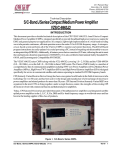
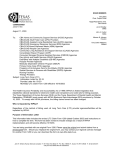







![SS400G MLSS Converter [Style:S2.2]](http://vs1.manualzilla.com/store/data/005726371_1-b873ef07ceb169a0226d293b313a67fd-150x150.png)
